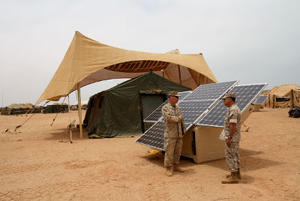In the trenchesMarines use solar power in Afghanistan to help fuel the fight
Marines at Forward Operating Base Jackson in the Sangin valley of Helmand Province are using solar energy generators to stretch fuel supplies and save lives; with over 100 British troops killed there, Sangin valley is one of Afghanistan’s deadliest areas; since the implementation of portable solar energy generators, fuel consumption has decreased from twenty gallons to less than three gallons a day; delivering fuel is incredibly dangerous as fuel convoys are often ambushed or hit by IEDs

Deployed solar panels at an ExFOB // Source: marines.mil
The Marines and sailors at Forward Operating Base Jackson in the Sangin valley of Helmand Province, Afghanistan have found that using renewable energy sources like solar to power their equipment is saving lives and helping them fight more efficiently.
The Marines of the 3rd Battalion, 5th Marine Regiment stationed in Sangin are part of a new program called the Experimental Forward Operating Base (ExFOB) that is designed to test alternatives to existing fuel based generators. In Afghanistan, transporting fuel to remote areas is often a deadly task on roads laced with ambushes, IEDs, and other dangers. By reducing consumption and extending supplies, solar power is literally saving lives by reducing the number of fuel shipments.
Staff Sgt. David Doty, who is deployed at an outpost of Forward Operating Base Jackson, says, “By saving fuel for generators, it has cut back on the number of convoys, meaning less opportunity for one of our vehicles to hit an IED.”
According to Doty, solar power has helped to stretch fuel. “Our generators typically use more than 20 gallons of fuel a day. We are down to 2.5 gallons a day,” he said.
In Sangin, one of the most dangerous areas in Afghanistan, cutting back on fuel consumption can make a serious difference.
Sangin has proven to be a deadly battlefield with more than 100 British troops killed there. British troops pulled out in late September of last year as U.S. Marines moved in.
Shortly after deploying, the 3rd Battalion, 5th Marine Regiment suffered nine casualties in one of the Marine Corps’ deadliest months of combat.
1st Lt. Daric Kleppe, who is also deployed at Forward Operating Base Jackson, concurs with Doty that reducing convoys is critical.
“The enemy will exploit every soft target we have,” he said. “A refueling vehicle becomes a screaming [easy] target.”
Forward Operating Base Jackson is currently using several portable solar powered generators to provide energy for communications equipment, lighting, and other electrical needs.
For smaller items like radio batteries, Marines are using the Solar Portable Alternative Communication Energy System (SPACES) a flexible solar panel that can be folded up and carried by a single person.
The PowerShade, a large solar tarp that is designed to fit over a standard Marine tent, can provide enough power to light a tent.
The Ground Renewable Expeditionary Energy System (GREENS) is a solar panel array capable of providing enough energy to run four computers at a time.
With six outsized solar panels, the ZeroBase Regenerator is the largest power source capturing enough solar energy to operate more than twenty lighting systems and fifteen computers at a time.
The Marine Corps is still battle testing solar powered generators and refining the equipment, but the preliminary results have proven encouraging.
Gunnery Sgt. Willy Carrion of ‘I” Company says, “Marines can sustain themselves on little food and water, but the time we have saved on convoys for fuel and batteries, has been crucial.”
The solar generators save fuel during the day when they are used to light their operation centers, and at night the stored power continues to light their tents.
Marines are finding that not running noisy generators at night also has security benefits.
“It’s way more tactical not running the generators at night,” says Staff Sgt. Greg Wenzel. “At night the noise of a generator can carry a long way, become a calling card for insurgents.”
Testing the equipment in real combat settings has proven invaluable to improving its design, says Maj. Sean Sadlier, the Expeditionary Energy Liaison Officer in charge of the region.
“Many of the recommendations would have been impossible to make during the pre-deployment training program,” says Sadlier. “Only through use during actual combat operations would the Marines be able to realize the capabilities of the equipment and the capabilities they would like to see.”
The efficiency of the gear is winning over doubters like Gunnery Sgt. Willy Carrion, who is now a firm believer in the benefits of the program.
“When we first got the gear, I was a skeptic,” he says, but after seeing “how crucial and important renewable energy is” he has become an advocate for the renewable energy systems.
“Every infantry battalion should have the ExFOB, it has proven to be an extremely valuable asset!”
